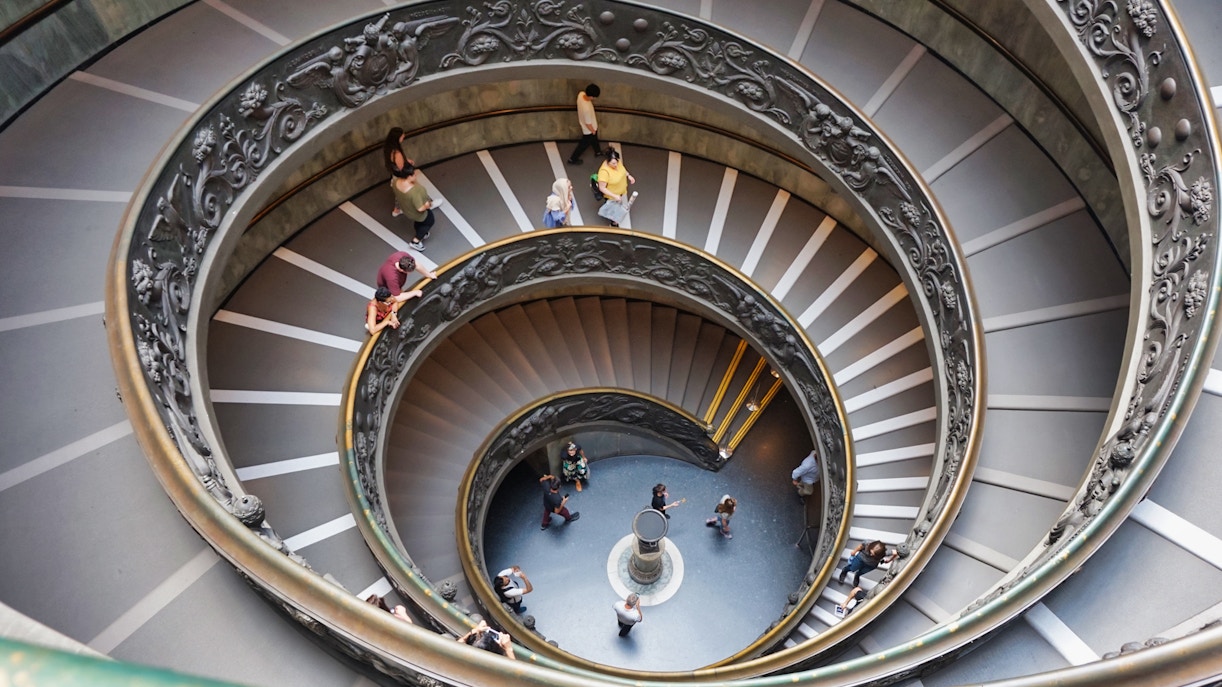- Vatican Museums
- Vatican Gardens
- Sistine Chapel
- Vatican Grottoes
- Apostolic Palace
- Castel Gandolfo Papal Palace
- Raphael Rooms
- Villa Barberini
- Basilica of St. Mary Major
- Vatican Library
- Castle Gondolfo
- Vatican Archives
- History
- Inside
- Paintings
- St. Peter's Basilica
- Vatican Easter Mass
- Tours in Italian
- Vatican Necropolis
- Christmas Tree
- Vatican City
- Nativity Scene
- Secrets of Vatican
- Plan Your Visit
- Skip the Line Tours
- Guided Tours
- Night Tours
- Timings
- Directions
- Rules
- Entrances
- Facts
- Map
- Papal Audience
- Private Tours
- Omnia Card
- Information at a glance
- Vatican Mass
- Dress Code
- Colosseum
- St. Peter's Basilica
- Rome Pantheon
- Castel Sant Angelo
- Musei Capitolini
- Roman Catacombs Tour
- Borghese Gallery
- Altare della Patria
- Doria Pamphilj Gallery
- Rome To Amalfi Coast Tours
- Rome To Tuscany Tours
- Bioparco Rome
- Big Bus Rome Hop-on Hop-off Tours
- Palazzo Barberini
- Leonardo da Vinci Museum
- Trevi Fountain Tours
Discover What’s Inside the Vatican Library | Library of the Holy See
Things You Didn't Know About the Vatican Library

- Founded in: 1475
- Founder: Pope Nicholas V
- Location: The Belvedere Courtyard, which is located within the Vatican Palace, serves as the entrance to the Vatican Library.
- Departments: Manuscript Department, Printed Books Department, Numismatic Department
- Collections: Manuscripts, Archival collections, Printed Books, Graphic Materials, Numismatic Collections, and Art Objects.

- Nearly 2,000,000 printed volumes and serials, including over 8,000 incunabula, are preserved in the Vatican Library.
- Between 1927 and 1939, the Library of Congress and the Carnegie Endowment for International Peace assisted with the modernization of the Vatican Library's book catalog system.
- The Vatican library has 75,000 manuscripts in Latin, Greek, Arabic, Hebrew, Persian, Ethiopian, and Syriac charting back to the 2nd century
- Approximately 6,000 new volumes are added to the library each year. Only about a quarter are purchased while the rest are gifts.
Vatican Library Collections

Manuscript Collections
The Vatican Library boasts an incredible collection of manuscripts. Some of the manuscripts housed inside the library include Carte d'Abbadie, Boncompagni Ludovisi, Libri minuscoli, Papiri Vaticani copti, Raccolta Rospigliosi, Vaticani musicali, and over 100 others.

Archival Collections
The Archival collection at the Vatican Library is equally impressive. The collection includes Archivio Barberini, Archivio Barberini Colonna di Sciarra, Autografi e Documenti Patetta, Computisteria Ottoboni, Pergamene Patetta, S. Maria in Cosmedin, and many more.

Printed Books Collections
The Vatican Library houses over 1,600,000 printed books, the majority of which are old and rare, including over 8,600 incunabula; tens of thousands of sixteenth-century editions, and seventeenth-century editions, particularly in the Barberini and Chigi collections.

Graphic Materials
The Graphics collection at the Vatican Library is home to some breathtaking pieces of art including Fondo Stampe, Fondo Stampe Geografiche, Raccolta fotografica, Fondo Bianchi Barriviera, and more. The Ashby Collection and the Gismondi Collection are two autonomous closed collections of a specified size that are part of the Graphics collection.

Coins and Medals
Coins, medals, plaques, stamps, inscriptions, carved stones, sulphur and plaster castings, and other materials are stored in the Vatican Library's Numismatic Cabinet, or Medagliere. Roman coins from the Republican Period, coins from Italy's towns and dominions, medals from other countries dating from the Renaissance to the present day, and more are also preserved here.
.jpg?auto=format&w=702.4499999999999&h=401.4&q=90&fit=crop&ar=7%3A4&crop=faces)
Art Objects
100s of non-book artifacts are displayed as ornaments throughout the Vatican Library, among the several valuables housed there. These pieces – artworks, sculptures, furniture, and other items – have been cataloged as Library Art objects. The art objects are categorized and included in the general catalog as well as the catalog of Graphic materials and Art objects, along with photos.

Special Project
The Vatican Library is also home to some special projects. These include IIIF Thematic Pathways, RICI - Books and Libraries of religious orders in Italy at the end of XVI cent, The Polonsky Project, Travel with Dante, and The Alamire project.

Vatican Secret Archives
The Vatican Secret Archives house all of the Holy See's acts, as well as state papers, letters, papal account books, and a variety of other documents acquired throughout the centuries by the church. The Secret Archives were split from the Vatican Library in the 17th century, when scholars had restricted access to them, and were completely inaccessible to outsiders. In 1881, Pope Leo XIII opened them for researchers, with 1000s examining its contents each year.
Know More
Vatican Film Library
The Vatican Film Library in St. Louis, Missouri, is the only repository of microfilms from the Biblioteca Apostolica Vaticana, the Vatican Library. It can be found in the Pius XII Library on the Saint Louis University campus. Lowrie J. Daly designed the library, which was funded by the Knights of Columbus. The purpose was to increase the accessibility of the Vatican and other materials to North American academics.
History of the Vatican Library

Origins
In the early half of the thirteenth century, the Popes' first library and archive were scattered for reasons that are yet unknown. Following Boniface VIII's death, new collections gathered by the Popes of that century were relocated to Perugia, Assisi, and eventually to Avignon. The popes who returned to Rome after 1415 attempted to reclaim the lost library heritage at various times; what was left in Avignon at the start of the 17th century ended up in the Borghese family's collection, which Leo XIII purchased in 1891.

Nicholas V to Sixtus V
The beginning of the modern history of the Vatican Library can be traced back to the mid-14th century. Nicholas V was the one who decided that scholars should be able to read and study the Latin, Greek, and Hebrew texts. With the appointment of a librarian, Bartolomeo Platina, and the required financial assistance, Sixtus IV resumed, finalised, and carried out Nicholas V's mission. The new institution was housed on the ground floor of a structure that Nicholas V had already renovated. From a total of 2,527 manuscripts in 1475 to a total of 3,498 in 1481, the collection continued to grow.

16th and 18th Centuries
The Library continued to grow in the 16th century, especially under Leo X, with methodical research and acquisitions of manuscripts and printed works. Throughout the 17th century, complete princely or private libraries started being incorporated into the collection. Many of these have been turned into unique, closed manuscript and printed book compilations, different from the open collections that began in the library itself. The 18th century saw the creation and gradual expansion of departments devoted to antiquarian and creative collections in the Vatican Library.

19th and 20th Centuries
When Rome was annexed to the French Empire in 1809, the Vatican Library became a National Library, and the holdings of religious orders were added. The library was opened to a greater public of academics and historians under Leo XIII, and the modern Reading Room for Printed Books was established in 1892. When the arrival of automobiles made the old stables at the Cortile del Belvedere obsolete in 1927, Pope Pius XI decided to convert them into stacks for the Library's printed books. New stacks holding manuscripts were created beneath the Vatican Library's internal courtyard from 1982 to 1984, thanks to funding from the German Episcopal Conference.
Manuscript Department
The Vatican Library's manuscript holdings are preserved, studied, and made available by the Manuscript Department. The Manuscript Section is in charge of the literary collections, which ranges to about 80,000 volumes. The Archive Section, meanwhile, was established at the end of the 1970s, is in charge of the conservation and maintenance of the larger archival holdings.

Manuscripts
More than a hundred collections constitute the Manuscript Section. These are extremely different, not least in terms of size, ranging from the Vaticani latini, which has 15,371 numbered objects, to collections made entirely of a single item. The Vatican Library is known as a library of libraries because of the variety of manuscript collections and their provenance. The library is notable not just for the Popes' ongoing efforts, but also for the addition of entire libraries that serve as reflections of other eras, worlds, and civilizations.

Archival Section
The Vatican Library did not construct a distinct section for collections that are more appropriately or even solely archival with the intention of segregating documentary material from manuscripts belonging to the same collections. Rather, it was bibliographical and operational considerations that prompted the library to establish the Archival Section near the end of the 1970s. Today, this section is the permanent home of the great archives that have come to the library at various periods and for varied purposes.

Reading Rooms and Stacks
The goal of this department is to guarantee that the Manuscript Reading Rooms and Stacks run smoothly. Additionally, its personnel notify the Department's Director of Manuscript Restoration about manuscripts that need restoration, as well as oversee duplication approval requests. Their job also include greeting and assisting scholars, as well as pointing out the most important tools for research work. They aid in the submission of digital manuscript requests and provide digital access to manuscripts.
Printed Books Department
The Printed Books Department manages the Vatican Library's printed book compilations, as well as its catalogues of prints, illustrations, and non-book materials, and makes them available to scholars. The department handles new publication purchases and exchanges of published material with other establishments. It also selects books donated to the Vatican Library and accepts those donated specifically to the Holy Father. The department is also responsible for cataloging the books that are introduced to the collection and ensuring that they are safely preserved in the stacks.

Accessions
Rare books, contemporary books, journals, digital resources, and other non-book resources are all handled by the Accessions Section. This section's primary responsibility is to handle the administration facets of integrating publications into the Vatican Library's holdings. The routine activities are mostly focused on acquisitions, but also deal with materials that come in via contributions or exchange programs.
.jpg?auto=format&w=1069.6000000000001&h=687.6&q=90&fit=crop&ar=14%3A9&crop=faces)
Catalog
Even though a unified catalogue for printed materials had been hoped for for a century, a systematic catalogue was finally organised in the 1920s. The contemporary general catalogue of the Vatican Library's printed books was established in 1928; previously, the various collections had their own catalogues, prepared in the scope of each collection and according to distinct criteria. The Vatican Library's cataloguing standards were initially published in 1931, and the third and final edition was issued in 1949.

Reading Rooms and Stacks
The Sala Leonina, which contains around 56,000 volumes and has 104 chairs, and the Sala Leonina Minore, which houses about 15,000 volumes, are the principal reading rooms for printed works at the Vatican Library. The Periodical Reading Room, officially opening to the public in 2002, contains 32 seats and offers easy accessibility to 949 scientific journals. Another reading area, the Salone Sistino, opened in October 2017, with around 28,000 books and 24 seats.

Rare Books Section
The Rare Books Section serves three purposes: to offer researchers with original sources for research, to continue specialised categorization of old books created before 1800, and to expand the Vatican Library's collections of old and valuable books. The first tangible goal of this section is to enter the published catalogue of incunabula into the OPAC. It intends to compile a more detailed catalogue of the incunabula in the second phase, which will also be made accessible online.

Collection of Engravings
The Vatican Library's Prints Cabinet is a significant artistic repository that houses engravings and unbound prints that are not bound into books or supported by written words. It also preserves a large number of drawings that have been part of the Vatican Library's collections over time and were included in the engravings collection based on the similarity of the required conservation practices. Many pictures, as well as chalcographic and xylographic plates, are included in this section.
Visiting Vatican Library

Monday to Friday: 9 AM to 12:00 AM
Tuesday and Thursday: 2:30 PM to 3:30 PM

- Researchers and scholars with appropriate qualifications and/or relevant scientific publications.
- Teachers and researchers at Universities and other institutes of Higher Education;
- Graduate students who are pursuing research for a doctoral dissertation;
- In rare cases, undergraduate students who can demonstrate that they need to consult material which is available only at the Vatican Library.

The Vatican Library is open to:
- researchers and scholars holding appropriate qualifications and/or relevant scientific publications;
- teachers and researchers at Universities and other institutes of Higher Education;
- graduate students who are pursuing research for a doctoral dissertation;
- undergraduate students who can demonstrate that they need to consult material that is available only at the Vatican Library.
- One needs to have a reader's pass to enjoy access to the Vatican Library.

You will need to get a reader's pass to gain access to the Library. The pass will only allow you to consult the printed book collection. To apply for the pass you would need a valid ID proof, and a reference letter or a valid document proving appropriate academic qualifications. Students will have to present a Letter of Surety, printed on institutional letterhead and signed by their dissertation supervisor.



